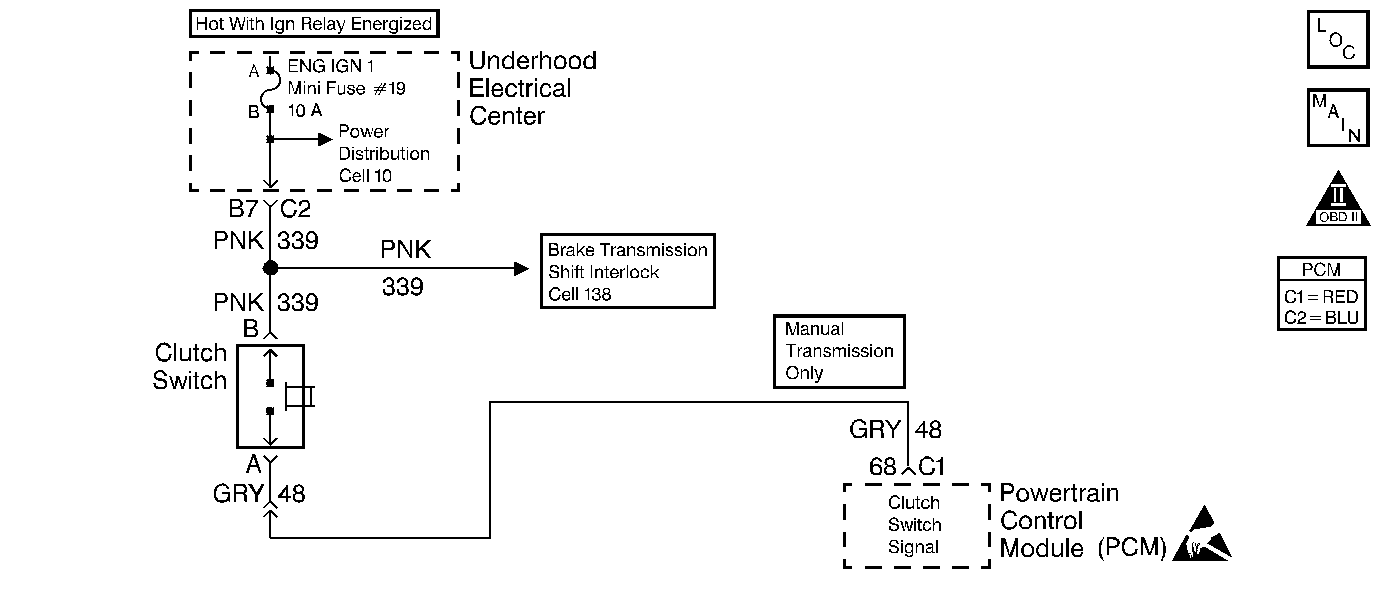
Circuit Description
The clutch switch is a normally closed switch. The PCM receives an ignition voltage on the clutch switch circuit when the clutch switch is closed. The PCM receives 0 voltage on the clutch switch circuit when the clutch switch is open.
This DTC determines if the Transmission Clutch switch has failed by looking for a clutch switch transition within a range from 0 mph to some higher speed.
Conditions for Setting the DTC
| • | No VSS DTCs. |
| • | Vehicle speed goes from 0 mph to greater than 24 mph and back to 0 mph for 2 seconds without the PCM detecting a clutch transition. This must occur 7 times before the diagnostic reports a fault. |
Action Taken When the DTC Sets
| • | The PCM illuminates the malfunction indicator lamp (MIL) on the second consecutive ignition cycle that the diagnostic runs and fails. |
| • | The PCM records the operating conditions at the time the diagnostic fails. The first time the diagnostic fails, the PCM stores this information in the Failure Records. If the diagnostic reports a failure on the second consecutive ignition cycle, the PCM records the operating conditions at the time of the failure. The PCM writes the conditions to the Freeze Frame and updates the Failure Records. |
Conditions for Clearing the MIL/DTC
| • | The PCM turns OFF the malfunction indicator lamp (MIL) after 3 consecutive ignition cycles that the diagnostic runs and does not fail. |
| • | A last test failed, or current DTC, clears when the diagnostic runs and does not fail. |
| • | A history DTC clears after 40 consecutive warm-up cycles, if no failures are reported by this or any other emission related diagnostic. |
| • | Use a scan tool in order to clear the MIL and the DTC. |
Diagnostic Aids
The following may cause an intermittent:
| • | Check for poor connections. Check for adequate terminal tension. Refer to Body and Accessories/Wiring Systems for proper procedure. |
| • | Corrosion |
| • | Mis-routed harness |
| • | Rubbed through wire insulation |
| • | Broken wire inside the insulation |
Refer to Transmission/Transaxle for clutch switch adjustment.
Using Freeze Frame and/or Failure Records data may aid in locating an intermittent condition. If you cannot duplicate the DTC, the information included in the Freeze Frame and/or Failure Records data can aid in determining how many miles since the DTC set. The Fail Counter and Pass Counter can also aid determining how many ignition cycles the diagnostic reported a pass and/or a fail. Operate the vehicle within the same freeze frame conditions (RPM, load, vehicle speed, temperature etc.) that you observed. This will isolate when the DTC failed. For an intermittent, refer to Symptoms .
Test Description
The numbers below refer to the step numbers on the diagnostic table.
Step
| Action | Value(s) | Yes | No |
|---|---|---|---|---|
1 | Did you perform the Powertrain On-Board Diagnostic (OBD) System Check? | -- | ||
Does the scan tool display change states when the clutch is depressed and released? | -- | Refer to Diagnostic Aids | ||
3 | Check the adjustment of the clutch switch. Refer to Transmission Transaxle/Manual Transmission. Was an adjustment necessary? | -- | ||
4 |
Does the scan tool display the Clutch Switch Released? | -- | ||
5 | Remove the jumper. Does the scan tool display the Clutch Switch Depressed? | -- | ||
6 | Probe the clutch switch ignition feed circuit with a test lamp connected to a ground. Is the test lamp illuminated? | -- | ||
7 | Check for a short to B+ on the clutch switch signal circuit. Refer to Body and Accessories/Wiring Systems . Did you find the condition? | -- | ||
8 | Check for poor terminal contact for the clutch switch signal circuit at the clutch switch connector. Refer to Body and Accessories/Wiring Systems . Did you find the condition? | -- | ||
9 | Check for an open in the clutch switch signal circuit. Refer to Body and Accessories/Wiring Systems . Did you find the condition? | -- | ||
10 | Repair the open in the clutch switch ignition feed circuit. Refer to Body and Accessories/Wiring Systems . Is the action complete? | -- | -- | |
11 | Replace the clutch switch. Is the action complete? | -- | -- | |
12 | Check the terminal tension at the PCM connector for the clutch switch signal circuit. Refer to Body and Accessories/Wiring Systems . Did you find the condition? | -- | ||
13 | Repair as necessary. Is the action complete? | -- | -- | |
14 |
Important:: Program the replacement PCM. Refer to Powertrain Control Module/Throttle Actuator Control Module Replacement . Replace the PCM. Is the action complete? | -- | -- | |
15 |
Does the scan tool indicate that this test ran and passed? | -- | ||
16 | Select the Capture Info option and the Review Info option using the scan tool. Are any DTCs displayed that you have not diagnosed? | -- | Go to Applicable DTC Table | System OK |
